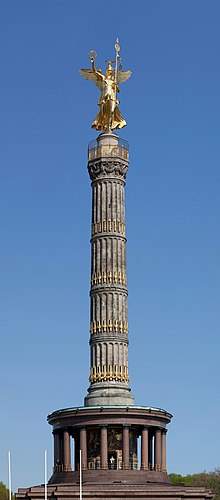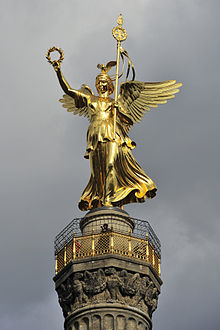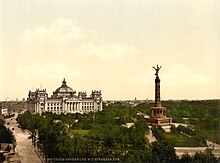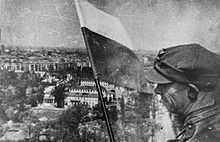
Back عمود النصر (برلين) Arabic Калона Перамогі Byelorussian Калёна Перамогі (Бэрлін) BE-X-OLD Колона на победата (Берлин) Bulgarian Siegessäule Breton Columna de la Victòria Catalan Siegessäule CEB Vítězný sloup (Berlín) Czech Siegessäule Danish Siegessäule (Berlin) German
Siegessäule | |
 | |
 | |
| 52°30′52″N 13°21′0″E / 52.51444°N 13.35000°E | |
| Location | Berlin, Germany |
|---|---|
| Height | 67m |
| Beginning date | 1864 |
| Completion date | 1873 |





The Victory Column (German: Siegessäule pronounced [ˈziːɡəsˌzɔɪ̯lə] , from Sieg 'victory' + Säule 'column') is a monument in Berlin, Germany. Designed by Heinrich Strack after 1864 to commemorate the Prussian victory in the Second Schleswig War, by the time it was inaugurated on 2 September 1873, Prussia had also defeated Austria and its German allies in the Austro-Prussian War (1866) and France in the Franco-Prussian War (1870–71), giving the statue a new purpose. Different from the original plans, these later victories in the unification wars inspired the addition of the bronze sculpture of Victoria, the Roman goddess of victory, 8.3 metres (27 ft) high, designed by Friedrich Drake, giving the victory column its current height of 67m.[1][2]
Berliners have given the statue the nickname Goldelse, meaning something like "Golden Lizzy", named after an 1866 novel by E. Marlitt and its heroine.[3] The Victory Column is a major tourist attraction in the city of Berlin. Its viewing platform, for which a ticket is required, offers a view over Berlin.
- ^ Alings, Reinhard (2000). Die Berliner Siegessaule: Vom Geschichtsbild zum Bils der Geschichte. Berlin: Parthas Verlag GmbH. pp. 35–51. ISBN 9783932529719.
- ^ Braun, Matthias (2000). Die Siegessaule. Berlin: Berlin Edition. p. 11. ISBN 3814800265.
- ^ Berlin Tourist Information – Tiergarten Archived 22 June 2008 at the Wayback Machine